Lebanese Fattoush Salad
Updated Jun 17, 2023
This authentic healthy Lebanese Fattoush Salad is made with seasoned fried pita bread, fresh vegetables and tossed in a zesty sumac dressing.
This post may contain affiliate links. Please read our disclosure policy.
This Lebanese Fattoush Salad is the quintessential salad that you’ll find at all Lebanese restaurants and throughout the Middle East. It’s a fresh and bright salad made with seasonal vegetables and topped with the iconic fried pita bread – perfect for serving with chicken tawook or beef kafta.
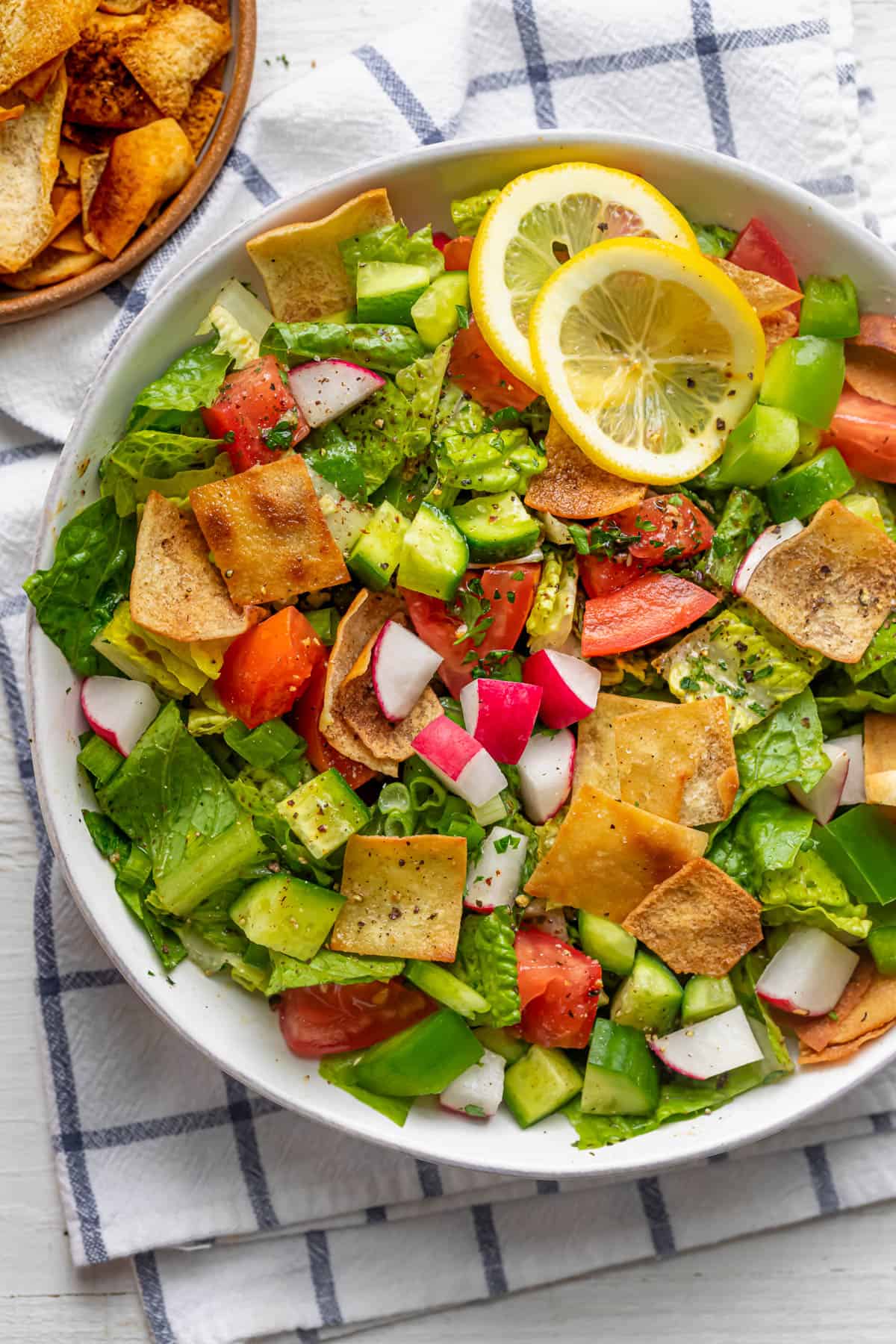
What is Fattoush?
Fattoush is basically a Mediterranean fried bread salad that typically includes lettuce, tomatoes, cucumbers, radishes and fried pieces of pita bread. You’ll also typically see green peppers, green onions and parsley.
In Arabic, the word “fattoush” is derived from “fatteh” which literally means “crumbs.” As you can imagine, this Fattoush Salad is basically a hodgepodge of pita bread that’s been seasoned then fried (or baked) in addition to other vegetables that are in season. For that reason, there are no rules when it comes to the vegetables you use in Fattoush! It’s a great base recipe that you can build upon and dress up how you’d like.
Recipe video tutorial
typical ingredients
- Lettuce: You can use romaine or iceberg lettuce, and you can even throw in some spinach.
- Parsley: Chop it up finely to add a fresh brightness to the salad.
- Tomatoes: Very common in fattoush salads and usually it’s the large varieties like roma or vine tomatoes, but you can also use cherry or grape tomatoes.
- Green peppers: Other types of sweet or spicy peppers work too.
- Cucumbers: It’s a key ingredient in many Middle Eastern salads, especially this one. Any cucumbers work, but Persian cucumbers are most popular.
- Green onions: While you can use white, yellow or red onions, green onions have a sweeter and more mellow flavor so they don’t overpower the dressing.
- Radishes: Try throwing radishes in fattoush to add a mild spicy and zesty flavor that’s crisp and fresh.
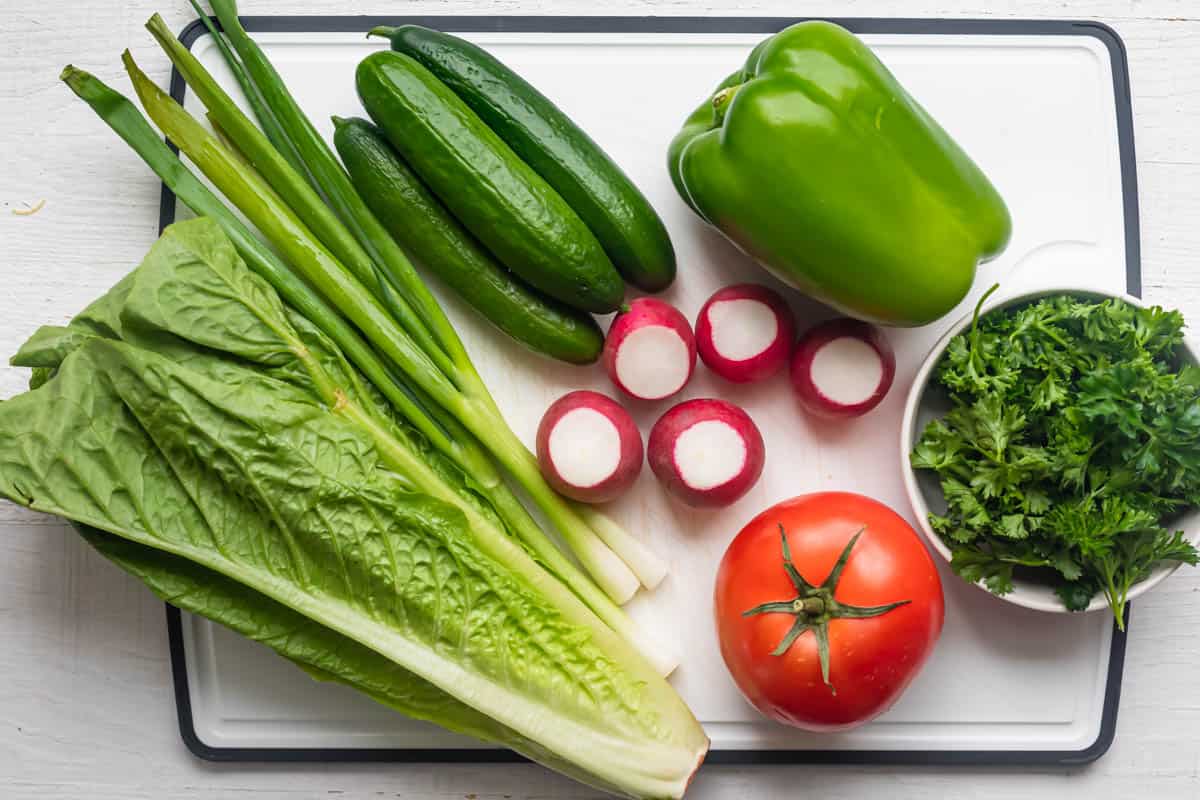
How to make fattoush salad
Chop the ingredients
- It’s a good idea to small dice all the ingredients so that every bite of fattoush is complete with all the textures and flavors of the salads.
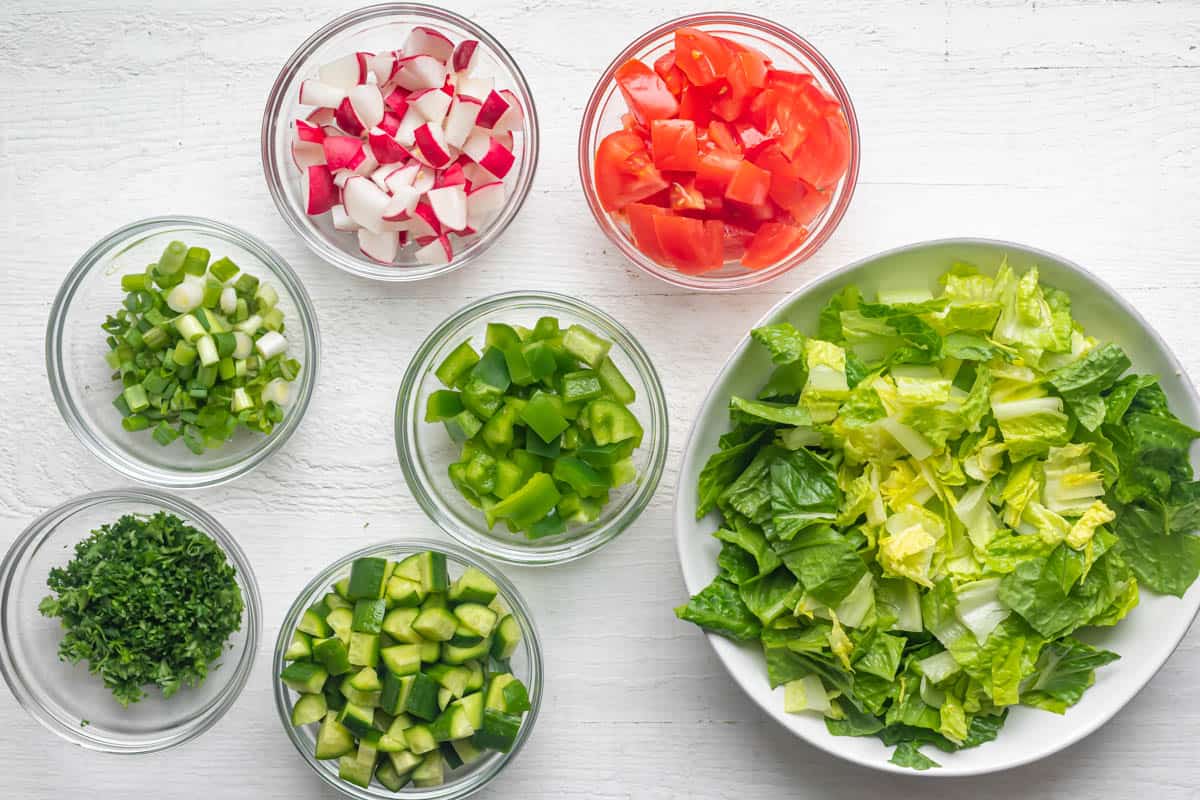
Make the dressing
- Made with extra virgin olive oil, fresh lemon juice, garlic, mint, sumac and pomegranate molasses, this zesty dressing is what separates authentic fattoush from all other fattoush. It helps the salad come together with a distinguished taste.

Fry the bread
- Cut the pita into the desired shapes (triangles, squares or strips). Toss with olive oil, salt and pepper and fry on medium heat.
- Make sure to stir frequently until the pita bread is lightly golden brown.
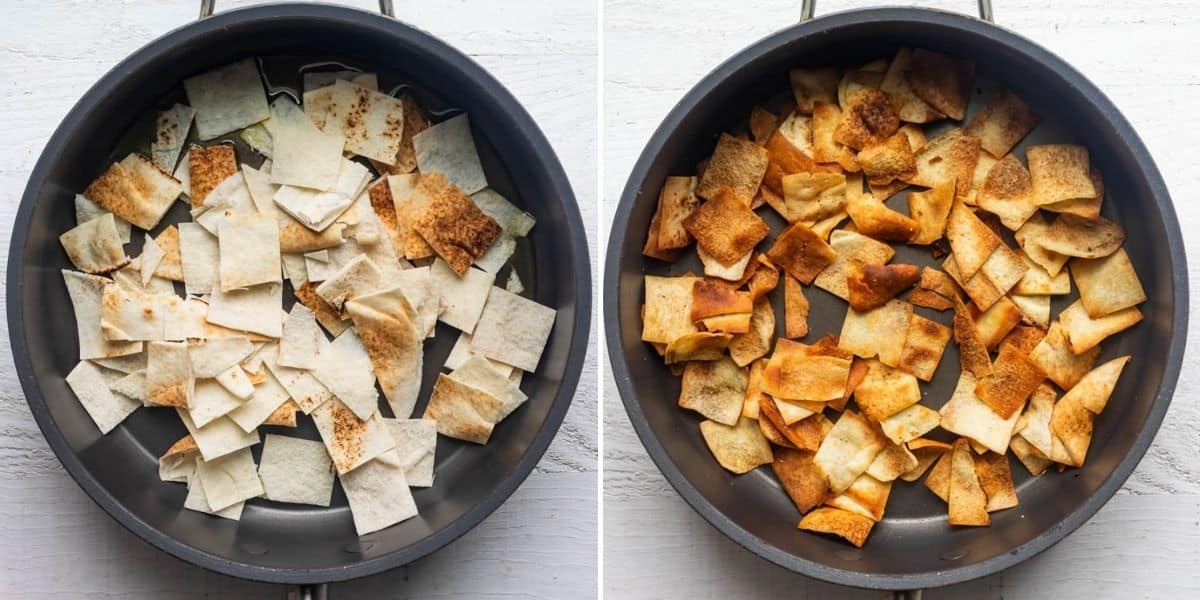
assemble
- Start building the fattoush salad by adding all the chopped ingredients to a large bowl.
- Pour the dressing on top.
- Toss everything to combine well. But keep the pita bread on the side so that it can be added when served to stay crisp.
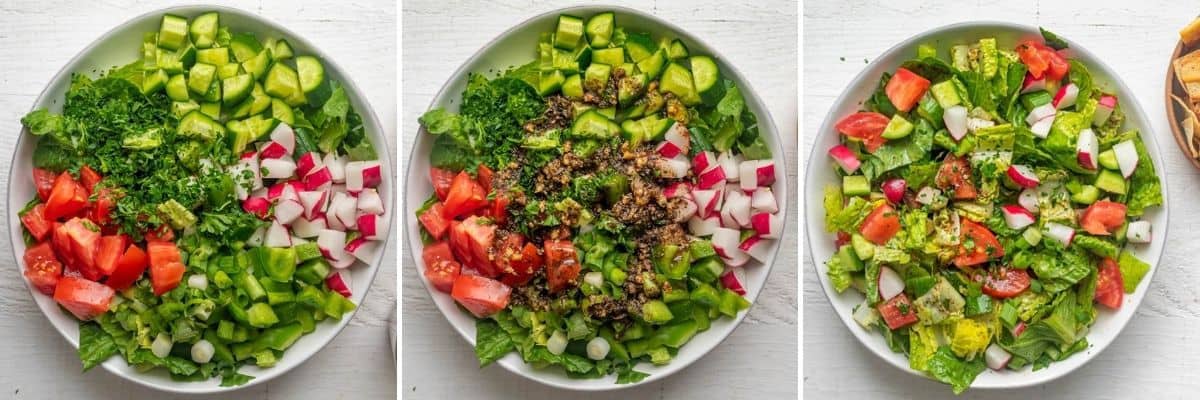
Tips for making the recipe
- Use the freshest ingredients possible for the best salad. It can be hard to do that during the winter months, but selecting high quality fresh vegetables will create the best results!
- Keep the fried pita on the side when serving. You can toss it on top right at the table or allow everyone enjoying the salad to add as much as they want.
- Make the dressing in a blender or small food processor. That will really help to emulsify the dressing so that it doesn’t separate. If you’re mixing by hand, it helps to press or grate the garlic to keep it fine.
Frequently asked questions
If the salad has not been tossed, you can store it in an airtight container for up to 4 days. If it has been tossed, it’s best to eat within 24 hours since it will be soggy after that. The dressing will keep well for up to 1 month in the fridge.
If you prefer to bake the pita bread, you can toss the bread, olive oil, salt and pepper in a baking dish and bake at 425° for 5-10 minutes, depending on the thickness of the pita bread you use.
This Arabic salad makes a great side that can be served along fish, chicken, meat or vegetarian and vegan dishes. It makes a great salad to serve at cook outs. Try it with:
Honey Lemon Salmon
Creamy Pesto Chicken
Vegan Creamy Tomato Pasta
Grilled Chicken Kabobs
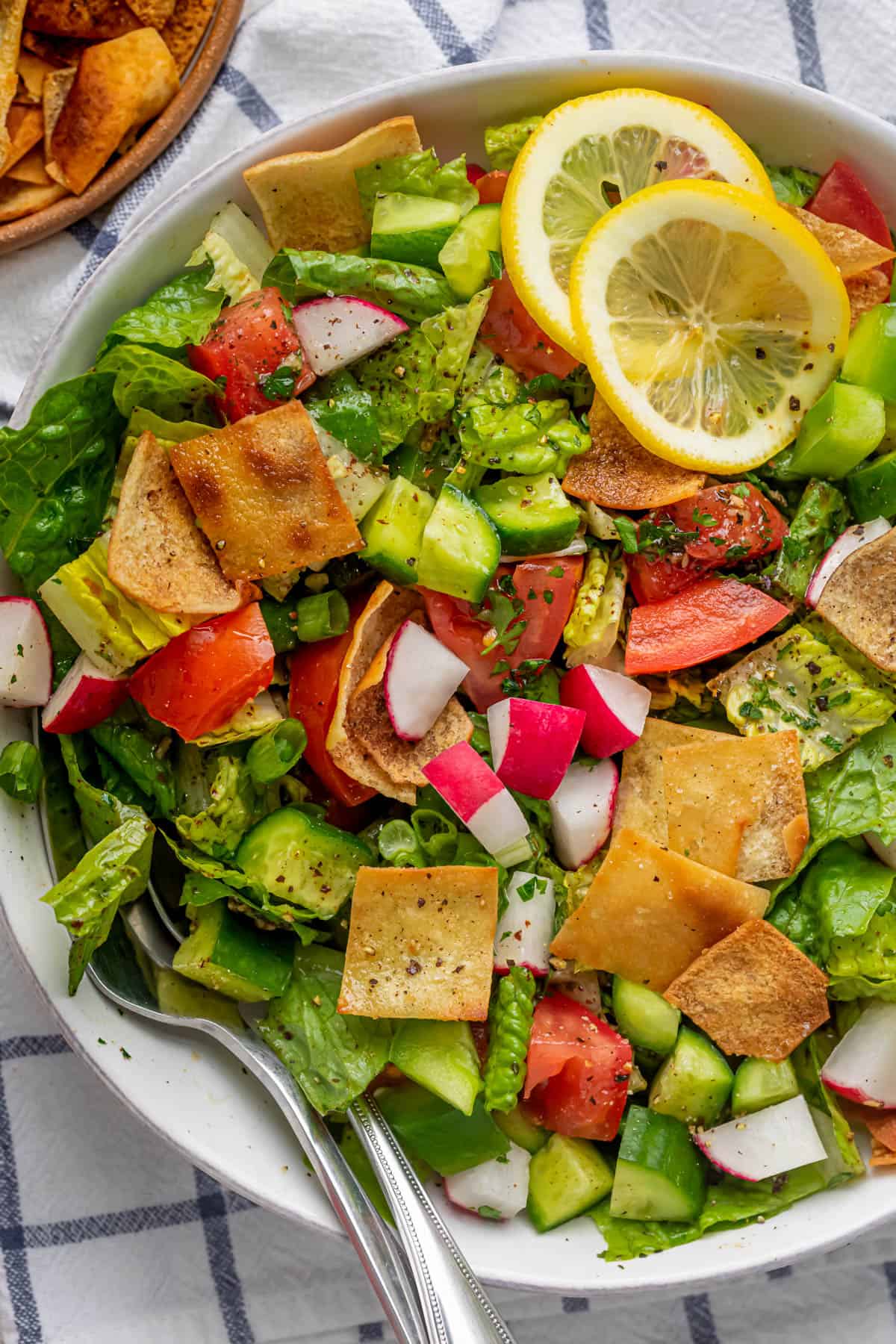
This fattoush recipe is vegan, fresh and fabulous and the best part is you can make it with with any vegetables you prefer. It’s a great side salad any time of year!
More Mediterranean salads:
- Mediterranean Pasta Salad
- Kale Tabbouleh
- Caprese Pasta Salad
- Lebanese Tabbouleh Salad
- Tomato Avocado Cucumber Salad
- Bulgur Chickpea Salad
If you’ve tried this healthy-ish feel good Lebanese Fattoush Salad recipe or any other recipe on Feel Good Foodie, then don’t forget to rate the recipe and leave a comment below! It helps others who are thinking of making the recipe. We would love to hear about your experience making it. And if you snapped some shots, share it on Instagram so we can repost on Stories!
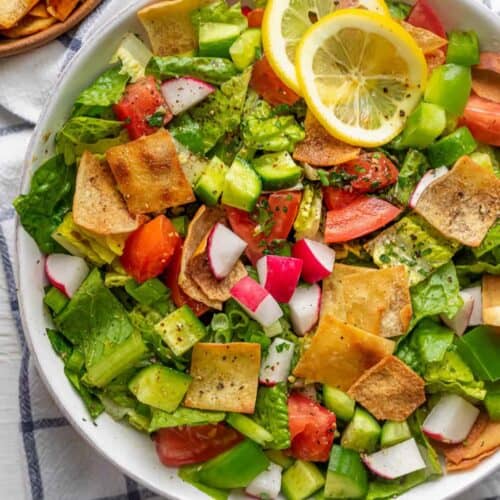
Lebanese Fattoush Salad
Video
Ingredients
Salad
- 1 large head romaine lettuce chopped
- 1 large vine-ripe tomato diced
- 2-3 Persian cucumbers quartered
- ½ large green pepper chopped
- 5 radishes diced
- 2 green onions sliced
- ¼ cup Chopped parsley
Dressing
- 3 tablespoon olive oil
- 2 tablespoon lemon juice
- 2 garlic cloves pressed or grated
- 1 teaspoon sumac
- 1 teaspoon pomegranate molasses
- ½ teaspoon dried mint
- ½ teaspoon salt
- black pepper to taste
Fried Pita Bread
- 1 large double ply pita bread cut into triangles
- 3 tablespoons olive oil
- Salt and pepper to taste
Instructions
- Make the Dressing: Whisk together the lemon juice, garlic, sumac, pomegranate molasses, dried mint, salt and pepper. Slowly stream in olive oil, whisking continuously until emulsified. Set aside.
- Fry the Pita Bread: In a large skillet, heat olive oil on medium heat. Add the pita bread and season with salt and pepper. Cook stirring frequently until the pita break becomes crispy and golden in color, about 5-7 minutes. Set aside.
- Place the lettuce, tomatoes, cucumbers, green peppers, radishes, green onions and parsley in a large serving bowl. Pour the dressing on top and toss to combine.
- Add the fried pita bread to the salad immediately before serving.
Notes
- Sumac can be found at specialty retailers in the spice section or on Amazon. If you can’t find it, substitute lemon zest for the closest taste.
- Pomegranate molasses can be tricky to find, but you’ll have the best luck at Middle Eastern Grocery stores or on Amazon. You can also make your own by reducing down pomegranate juice (with or without sugar). You can leave it out of the recipe or substitute balsamic glaze.
Nutrition
Nutrition information provided is an estimate. It will vary based on cooking method and specific ingredients used.






Comments
What kind of mint do you use please? Spearmint or peppermint, or another kind?
Hi there! Spearmint is typically used for dried mint seasoning.
I want to convert your recipe to feed 90 people as a side dish with many other main & side dishes. Have you ever converted it for larger crowds? If yes, any advice?
Sorry, I haven’t before! I’ve doubled and tripled this recipe before but that’s about it!
I normally don’t write reviews, but this salad was SO good. I live in Metro Detroit, and we have a ton of great Lebanese restaurants, but this salad definitely topped them. So fresh, easy and delicious. I baked my pita chips instead of frying, and they turned out wonderful. This is one of those recipes that packs restaurant-style flavor at home. Thank you for giving me another salad at home that sets the bar for when I go out.
Wow, that is so sweet!! Thank you so much, Nick! I’m so happy you love the recipe!!
Saving this as Fattoush Salad is one of my absolute favorites.
Yay, I hope you love it!!
I have made this recipe multiple times! This salad never disappoints! It’s so fresh and perfect for hot summer days when you don’t want to cook.
Yay! So happy to hear it! It’s my favorite!!
It looks like a great recipe. Unless I missed it, it would be awesome to have it in a ‘print recipe’ format. Thank you for posting your recipe.
Hi there! I actually do have a print function. You can scroll down to the recipe card and click the printer icon (on the photo) to get the printable version of any of my recipe (in this case, it will bring you to this link: https://feelgoodfoodie.net/wprm_print/lebanese-fattoush-salad). Hope that helps!
See All Comments